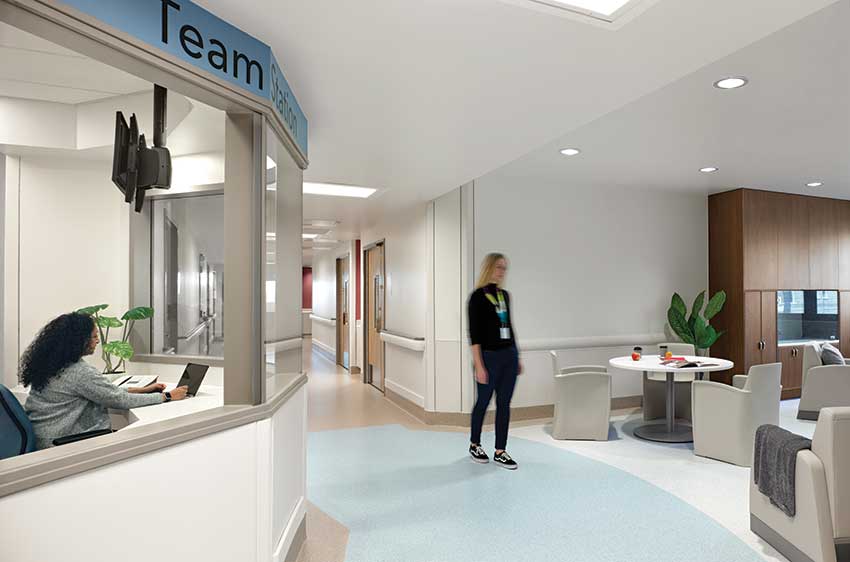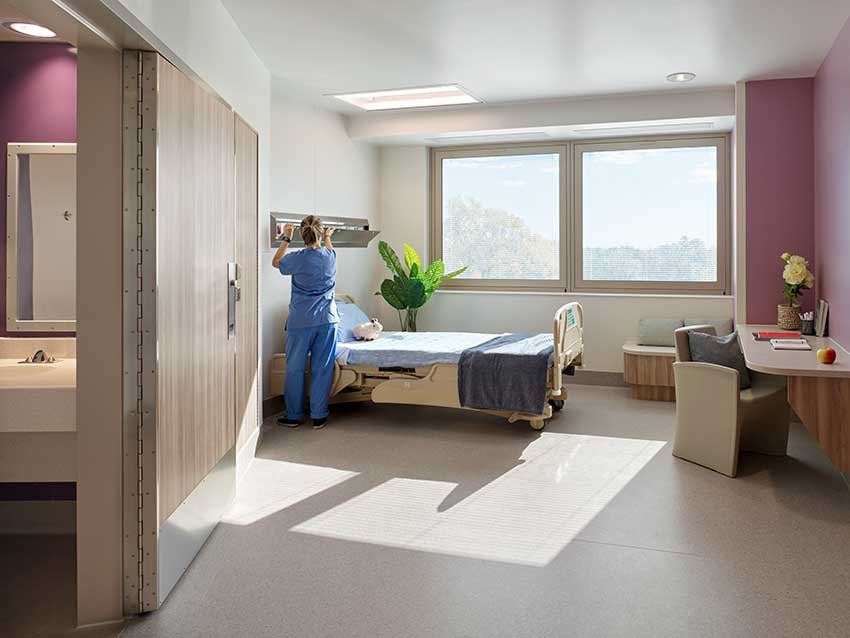Designing Spaces for Behavioral and Mental Health Treatment
Learning Objectives:
- Identify key flooring decision drivers and how making informed decisions supports evidence-based design principles for behavioral and mental healthcare environments.
- Discuss the primary resources and research related to behavioral and mental healthcare environments as a tool for the architecture and design community and health systems or centers.
- Define the impact of interior finishes on the cognitive, emotional, psychosocial, and physical needs of patients, residents, staff, and caregivers.
- Describe why the floor matters, health, wellness, and safety from the subfloor to the surface finish.
Credits:
This course is approved as a Structured Course
This course can be self-reported to the AANB, as per their CE Guidelines
Approved for structured learning
Approved for Core Learning
This course can be self-reported to the NLAA
Course may qualify for Learning Hours with NWTAA
Course eligible for OAA Learning Hours
This course is approved as a core course
This course can be self-reported for Learning Units to the Architectural Institute of British Columbia
A 2023 study by Mental Health America identified that 5.44 percent of adults experience severe mental illness. More than 12.1 million adults (4.8 percent) have reported serious thoughts of suicide. This is why “place” matters.

Photo courtesy of Ben Rahn/A-Frame
To enhance healing, settings for behavioral and mental healthcare need to balance safety with a warm, comfortable atmosphere. That includes plants, views of nature, natural wood, places to socialize, resilient flooring, and soft colors. Project: Michael Garron Hospital, inpatient mental health units designed by B+H Architects, Toronto, Canada.
The Advisory Board, which focuses on healthcare research,1 states, “Behavioral health encompasses people’s psychological well-being and ability to function in everyday life. Behavioral health conditions include mental illness disorders and substance abuse disorders.” They also note, “Health systems are increasingly recognizing that behavioral health is an essential part of physical and population health.” There is a growing demand for centers to support behavioral and mental health issues, yet access to reliable behavioral health services is challenging. When the opportunity to design new construction or renovation presents itself, this educational unit will provide oversight and baseline considerations. There is an overarching need for centers to provide effective, specialized residential, inpatient, and outpatient treatment. Demand facilitates that architects and designers will be tasked with planning and constructing care centers in various geographic settings. While these facilities fall into the healthcare category, aesthetically and functionally they require a different design approach. Evidence-based research shows that behavioral and mental health patients heal better in a warm and welcoming environment. There is concern patients may self-harm or harm others, which requires a unique level of detail for safety with interior finishes. There is a defining need for a calming, homelike aesthetic balance. The floor is the foundation; it supports all activities and can have an actionable impact on fostering safety and outcomes. This educational course demonstrates the design guidelines and needs of behavioral and mental healthcare center facilities. The Advisory Board shares that “Treating patients with behavioral health diagnoses costs about $900 more per month than patients without such diagnoses.” This is why the floor matters, from the subfloor to the surface finish, to have an actionable impact on outcomes.
THE NEED FOR EVIDENCE-BASED DESIGN FOR BEHAVIORAL AND MENTAL HEALTHCARE ENVIRONMENTS
The Advisory Board states that regardless of demographic group, patients with behavioral health conditions experience unique inequities compared to patients with only physical health conditions. The pandemic and its ripple effects only exacerbated an existing crisis in the U.S. The behavioral healthcare sector struggles with a unique "meta" inequity. So, when given the opportunity to design a BMH center, apply evidence-based design principles.
According to the National Institute of Mental Health, the spectrum of behavioral and mental health (BMH) conditions includes anxiety, attention deficit disorders, autism spectrum disorders, bipolar disorders, depression, obsessive-compulsive disorders, post-traumatic stress disorder (PTSD), substance abuse, and suicide, among others.3
Behavioral health treatment has undergone a shift, as have the means of delivery, which enables new centers that support a normalizing environment to ensure a return to a productive life within the community. Treating people who have mental illness is critically important. However, how and where to do so is not always clear. Some emergency rooms are not well equipped with crisis intervention spaces to treat patients of varying acuity levels. Increasingly, centers specifically created to treat individuals experiencing behavioral and mental health crises are desperately needed.

Photo courtesy of Ben Rahn/A-Frame
In behavior and mental healthcare facilities, biophilic features, warm colors, and the right flooring specification for the right place benefit not only patients but also staff, care providers, and visitors. Project: Michael Garron Hospital, inpatient mental health units designed by B+H Architects, Toronto, Canada.
Behavioral and Mental Healthcare is Cost-Effective
Understanding that behavioral and mental health conditions affect one in five adults in the U.S. each year, these illnesses are even more common among patients receiving care for medical conditions. According to The Center for Health Design (CHD)4, which provides guidance for the safe and therapeutic design of healthcare facilities, “Up to 45% of patients admitted to the hospital for a medical condition or presenting to the emergency department with a minor injury also have a concurrent BMH condition.” The Center states these comorbidities “increase the risk of psychological harm associated with care.” Therefore, providing BMH patients with a healing, therapeutic environment is an overarching design driver in these care settings. “Design interventions aimed at improving the psychological well-being of patients with BMH comorbidities may be more cost-effective than they initially appear, because they can be leveraged to support improved well-being for other populations as well, including other patients, staff, and visitors,” according to the CHD.
Design for facilities to care for this patient type is complex. Types of mental health facilities include:
- Crisis Units
- Residential mental health facilities
- Psychiatric hospitals (inpatient)
- Hospital environment
- Behavioral health clinics
- Pediatric and adolescent adult
- Memory enhancement centers for dementia
- Mental health rehabilitation (outpatient rehab – intensive or traditional)
McLean Hospital, a member of Mass General Brigham in Massachusetts, the largest psychiatric affiliate of Harvard Medical School, is America’s number one hospital for psychiatric care, according to the latest U.S. News & World Report annual “Best Hospitals” survey. While the facility treats serious psychiatric conditions based on the latest research, they recognize that a homelike setting is the best place to heal physically, mentally, and emotionally. Here is how they describe their residential treatment facility: “The Pavilion, located on McLean’s historic main campus, offers patients a peaceful treatment setting. Our comfortable environment, attractive decor, and range of high-quality amenities are designed to help individuals focus on treatment as well as their overall health and well-being.”

Photo courtesy of The Center for Health Design
A Safety Risk Assessment can be approached systematically.
Human-Centered Design
There is compelling evidence5 that certain design features support healing and psychological well-being in BMH settings. The CHD offers this list:
- A homelike, deinstitutionalized environment that supports patient autonomy and control over their own environment
- A well-maintained and well-organized environment
- Noise control
- Support for privacy
- Access to daylight and views of nature
- Physical access to the outdoors
- Support for feelings of personal safety/security
- Support for social interaction
- Positive distraction
PRIMARY RESOURCES RELATED TO BEHAVIORAL AND MENTAL HEALTH FACILITIES FOR THE DESIGN COMMUNITY
Credible research informs design decisions of the physical environment to encourage the experience of care and allow clinical staff and patients to heal together. These resources support appropriate design decisions:
The Center for Health Design: Evidence-Based Design (EBD)
The Center for Health Design (CHD)6 launched in 1993 as a team of forward thinkers with a vision for creating healthcare facilities that promote healthier environments for patients and staff. CHD is widely credited with defining EBD as “the deliberate attempt to base building decisions on the best available research evidence with the goal of improving outcomes and of continuing to monitor the success or failure for subsequent decision-making.” The CHD is a leading knowledge repository force in transforming hospitals, clinics, wellness centers, doctor’s offices, and residential care facilities through design research, education, and advocacy.
The Knowledge Repository
CHD also offers access to the knowledge repository, a complete, user-friendly database of references to healthcare design research that continues to grow with the latest peer-reviewed publications.


















